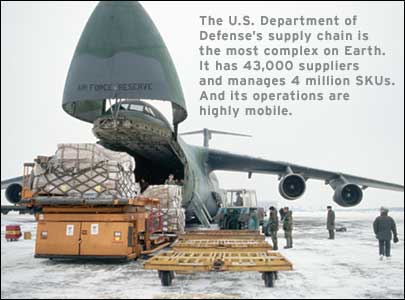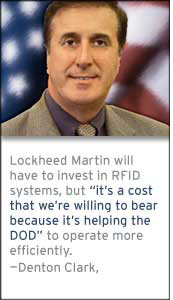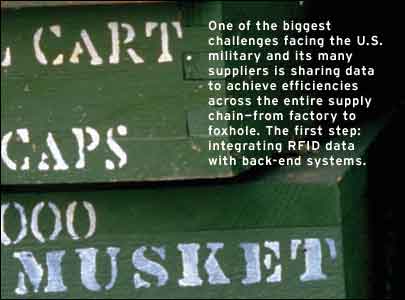“As you move into some of these military operations, you can have fairly thin pipelines, and it’s important to move supplies,” says Alan Estevez, assistant deputy undersecretary of defense for supply chain integration. “RFID helps you get good inventory information into the system if you have good business processes to go with it. RFID is not going to enhance the reliability of weapons systems, but it can enhance the readiness of the systems if you move the right parts to maintain the weapons systems.”
To achieve this ambitious goal, the DOD is requiring its suppliers to use passive RFID tags on all pallets, cases and certain items. It’s a tall order that could make the DOD and the entire defense industry in the United States more efficient and competitive. But it will likely be years before the vision becomes a reality.
|
|
The DOD has, without doubt, the most complex supply chain on earth. It has 43,000 suppliers and manages 4 million stock keeping units (SKUs)—everything from socks to airplanes. The Defense Logistics Agency (DLA), which supplies the four military branches—Air Force, Army, Navy and Marines–with most of their food, clothing and equipment, operates 18 distribution depots in the United States. Plus the branches have their own maintenance and parts warehouses, which supply troops with replacement parts. These supply depots and parts warehouses ship goods to fixed and mobile bases around the world. And the DOD must be ready to mobilize for war at any moment. Because military units could be deployed to almost any region of the world, it cannot predict where products will be shipped.
A different approach
The DOD’s implementation approach is different from that of Wal-Mart and others. Most retailers have asked their top suppliers to begin shipping pallets and cases of a small number of SKUs to a few distribution centers. These suppliers are required to pay for the tags. Over time, the retailers want the suppliers to tag more SKUs and ship them to more distribution centers. As the rollout progresses, retailers will require more suppliers to start tagging goods.
Instead of starting with its top suppliers, the DOD is focusing on high-value goods from all of its suppliers (see “RFID Marching Orders” on opposite page). And the DOD is not asking its suppliers to pay for the tags; it expects the cost of the tags to be factored into new procurement contracts.
The DOD is working with the Office of Management and Budget, an executive branch agency that oversees procurement policy, to revise the regulations that govern all DOD contracts to include RFID tagging as part of new contracts. Suppliers will be affected in 2005 only if they ship certain commodities to two DLA facilities (see RFID Marching Orders for details). Additionally, their contracts need to contain language regarding the requirement. The DOD is advising existing suppliers to ask their contracting officers about the timing and requirements for RFID tagging.
Because the DOD intends to include the tagging requirement as part of new and renewed contracts, rather than issuing a blanket requirement as of a certain date, suppliers have been confused about exactly who will be affected by the tagging mandate and when. Ann Grackin, CEO at ChainLink Research, a Cambridge, Mass., logistics consultant who advises the U.S. military and defense contractors, conducted seminars on defense industry supply chain issues during the past year for suppliers. She says many of them didn’t realize that the DOD mandate would apply to their companies.
That’s not as surprising as it sounds. The DOD itself doesn’t know how many of its suppliers will have to begin tagging goods in early 2005—or how many of them will be ready. Each of its four branches uses many different methods of ordering and procuring supplies and equipment. Contracts are renewed at different times, and there’s no standard way of tracking purchases and shipments. At press time, the department was conducting a review to determine which suppliers would be affected initially by the mandate, according to Sandra Burr, a DOD spokeswoman.
To help businesses meet its RFID requirements, the DOD has launched an extensive outreach program, including making presentations at industry conferences and working with associations. But even some suppliers that are aware of the mandate say they’re struggling to meet the requirements because the DOD hasn’t given them enough detail on how to implement the technology. An executive at a company that supplies fabrics to the military, who asked that he not be identified, says the DOD hasn’t told his company how or where the tags should be applied on its products. “I’ve spoken to other DOD suppliers,” he says. “We’re all in the same boat; we’re waiting to see what’s going to be required.”
Supply chain impact
Just as Wal-Mart and other retailers believe that passive RFID technology can make the entire consumer goods supply chain more efficient, the defense industry stands to gain from adopting RFID, according to Estevez. “When you look at the big companies like Boeing and Lockheed, they have massive industrial requirements themselves,” he says. “They can benefit from RFID the same way we will.”
Major defense contractors share Estevez’s enthusiasm for RFID and are hoping to reap supply chain benefits as they prepare to meet the DOD requirements. They believe the technology, when fully deployed, will enable them to reduce inventory levels, cut waste, improve their own manufacturing processes by allowing them to track parts, and improve their ability to deliver goods to DOD facilities when needed with a higher degree of precision and accuracy.
Lockheed Martin, the world’s largest defense contractor, is taking a phased approach to passive RFID implementation over the next several years. Because Lockheed Martin doesn’t ship products to the DOD distribution centers in San Joaquin, Calif., and Susquehanna, Pa.—the first sites where RFID will be deployed—the mandate will have a minimal impact on the company in 2005. “There will be a much more significant impact in 2006, when many more distribution centers will be RFID-enabled,” says Denton Clark, systems integration manager for the Bethesda, Md.–based company. “We deliver to many of those places.”
Lockheed Martin is in the process of developing a corporate policy for tagging all cases and pallets to be shipped to the DOD that carry repairables, electronic components and other equipment. The company is also exploring the possibility of tagging individual items.
Even though the DOD could absorb the cost of the tags (by including the cost in new contracts), suppliers still have to invest in readers and infrastructure to get any value from RFID internally and to be able to share data with the DOD and other supply chain partners. Clark would not say how much Lockheed Martin is spending on its RFID deployment. And he says it’s too early to tell what the financial returns will be from RFID or when the company will see a return on its RFID investments.
“It’s a cost that we’re willing to bear because it’s helping the DOD” to operate more efficiently, Clark says. “When we ship RFID-enabled containers to the DOD, they will have better visibility into what’s in the containers and can process deliveries much more quickly.”
Lockheed Martin is making sure that its own suppliers—which total more than 2,000—are aware of and abide by the DOD requirements wherever appropriate. That means if the DOD requires components to be tagged and a supplier provides those to Lockheed as part of a subcontract, the supplier puts on the RFID tag. Lockheed has not ruled out requiring all of its suppliers to tag shipments to its facilities.
Boeing, another major DOD contractor, also is unaffected by the mandate until 2006. The company—which before the mandate was announced began exploring the use of RFID to track “time- and temperature-sensitive” materials such as frozen sealants—is still determining how it will build an RFID infrastructure and how much its RFID deployment will cost. The company started tagging some pallets and cases in November 2004 and expects to be ready to meet the DOD’s requirements by the middle of 2005, according to Steve Georgevitch, supply chain manager at Boeing’s Integrated Defense Systems group in St. Louis.
Boeing and Airbus have agreed on a standard for using RFID in their own supply chains, so thousands of companies that make parts for commercial airplanes will have to adopt the technology. Many of these suppliers also make parts for military aircraft. By requiring suppliers to tag parts, the large defense contractors can gain internal efficiencies and better inventory accuracy.
This is the strategy that Northrop Grumman is adopting. The Los Angeles–based provider of electronic systems for ships and planes, command and control systems and space technology, says it will require its suppliers to use RFID tags on shipments. Northrop is still determining how best to deploy the technology internally to track products and meet the DOD requirements, but in September 2004 it began using 915 MHz passive RFID tags to track high-value assets internally. The company will evaluate the deployment to see whether it will be used to track other products, says Keith Reynolds, manager of business development, automatic ID technology.
Smaller suppliers will have to figure out how to meet not only the tagging requirements of the DOD but also those imposed by Boeing, Lockheed, Northrop and other major defense contractors. And smaller suppliers are likely to get fewer benefits, at least at first, because they’ll have to bear the cost of putting tags on shipments sent to the major defense contractors. Also, they don’t maintain huge inventories or have complex supply chains, so they have fewer inefficiencies to squeeze out of their operations.
Significant challenges
It will likely take years to transform the military supply chain and achieve the efficiencies the key players dream of. That’s because the DOD is a much different kind of organization from Wal-Mart and has a much less predictable supply chain operation. “Wal-Mart’s mandate looks much simpler,” says ChainLink Research’s Grackin. The DOD’s various branches receive products in different ways, she adds. “Every procurement manager has a different fiefdom; every product area—from tires to jet fighters—has different contracts, buying terms and IT requirements.”
Another major challenge for the DOD and its suppliers is that many of the items they handle—ammunition, weapons, spare parts for planes, tanks and trucks, and so on—are made of metal. Tags on metal items or even on containers containing metal parts can be challenging to read reliably. The DOD will have to work closely with the industry to solve these problems. (Radio waves can actually detonate some explosives, so the DOD is currently determining the minimum distance required between UHF readers and ordnance.)
And tagged products will be sent to hostile environments, such as the deserts of the Middle East, where high temperature could affect the tags, or the jungles of Asia, where humidity could reduce their effectiveness. The DOD is currently testing tags to see how well they stand up to these conditions.
But the biggest challenge is sharing data to achieve efficiencies across the supply chain—from factory to foxhole. The first step for both the DOD and its suppliers will be integrating RFID data with back-end systems. To meet the DOD’s mandate, Aviall Services, a Dallas–based provider of aviation parts and related aftermarket services, began installing RFID tags from Catalyst International on pallets stacked with parts at its 225,000-square-foot warehouse in Dallas in September 2004.
The hardest part of the implementation is ensuring smooth integration between the RFID readers and Aviall’s warehouse management and enterprise resource management systems, says Charley Kienzle, Aviall’s senior VP of operations. Aviall plans to use a middleware product from Sybase to ensure that data from readers is accurately interpreted by the back-end applications. The data will be used to more accurately track inventory in the warehouse as part of their operations, not for analytical purposes.
Kienzle says the RFID deployment will cost Aviall, which had $1.15 billion in revenue in 2004, about $200,000, and the initial payback will be minimal. “We would not be doing this if not for the DOD mandate,” Kienzle says. “But this keeps us on the cutting edge within our industry. I think the real payoff is long-term.”
For the system to pay off for both the DOD and the defense industry, the DOD will need to share data with its suppliers. Initially, the DOD plans to use existing electronic data interchange networks. There will be many challenges to overcome, including synchronizing accurate data, sharing information securely and changing business processes to reduce costs and complexity within in the industry’s supply chain.
It’s a tall order, but if Estevez’s vision can be realized, the defense industry will be leaner and more efficient, which means companies will be more competitive in global markets. And the U.S. military will be able to ensure that troops in the field always have all the supplies they need to fight effectively.





